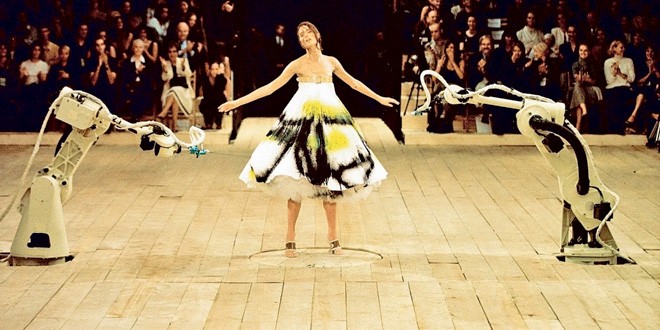
The rise of a ready to wear revolution has resulted in the death of innovation and creative expression in Pakistan. Can someone step in and save style?

I like to think of fashion as poetry in motion.
Fashion is a portrayal of fabulous ideas, fantasy and creativity that has the power to inspire awe. Strong fashion motivates us; it is supposed to visually excite us while the best of fashion will have the power to start a conversation. The dynamism of a successful collection is very simple: the more exciting it is the more hype it will create, the more creative its showcase, the more attention it’ll generate and coming full cycle, it will translate to success in every interpretation of the word. If poetry is judged by idea, vocabulary and structure, then fashion similarly rests on innovation and creative expression.
But if fashion were to be judged by innovation and expression, then fashion in Pakistan should be considered as good as dead. It’s lacking originality and purpose, unless that purpose is sales, which unfortunately is the only driving force these days. What happened to the business of making beautiful, thought provoking clothes? Anyone around in the ‘90s would remember unforgettable collections put together by Nilofer Shahid, Shamaeel and Rizwan Beyg. They were historic, panoramic.
Fashion was exciting even five years ago, back when fashion weeks began. If Sonya Battla’s tribute to Karachi paid homage to her distressed hometown then Karma’s fun loving Dr. Seuss was dedicated to Cat in the Hat. When a revivalist like Faiza Samee played with colours and crafts of her region, a modernist like Ammar Belal designed a collection in honour of Michael Jackson when he died. Stories unraveled when collections unrolled on the runway. Fashion was diverse and unique. Designers had signatures and those signatures were expressed in the form of spectacular shows.
Karma’s Dr. Seuss showcase is unforgettable, as is Ammar Belal’s Michael Jackson collection featuring Sonu Dangerous. Nomi Ansari has pulled off circus acts (with an entourage of circus performers), he brought out a Salman Khan doppelganger and he also did a showing entirely with celebrities from all walks of life. HSY has always brought drama to the runway while for Iman Ahmed, that drama has always risen from the clothes she designs. The runway, in a nutshell, used to be an exciting place because fashion was exciting. Moreover, when it came to gimmickry, Pakistan’s runways experienced some very cool acts that branched off from some very haute designers.
I feel the issue of gimmickry also needs clarity. While runways at three of the country’s best platforms - the PFDC Sunsilk Fashion Week, the PFDC L’Oreal Paris Bridal Week and Telenor Fashion Week - have gone flat, the level of entertainment witnessed at a parallel fashion platform like Bridal Couture Week does fashion no favours either. Bringing in musical acts and dance sequences that have nothing to do with fashion is not the way to impress. Gimmickry and conceptual shows need to complement fashion, not deplete or overshadow it. We cannot achieve the level of showmanship exhibited by Chanel, Dior or Master of the Spectacular, Alexander Mc Queen, but we need to hold them as examples of what a fashion presentation merits. It needs to reincarnate a collection in the most spectacular way ever.
But fashion appears to have gone flaccid. And therein lies the problem.
Creativity has been replaced by unabashed consumerism. There is no hesitation in showing what will be easy to sell; there’s no urge to push the creative envelope. There are very few committed designers left, designers like Iman Ahmed and Sonya Battla, who always manage to break the monotony of mundane fashion when they show. But they show once a year, maybe less, and they’re engulfed by a huge wave of mediocrity. Not many of Pakistan’s young, new designers have ideas or intellect. They can barely manage pretty clothes but to create collections, contextualizing them with innovation, is beyond their bounds. One doesn’t expect the level of a Rei Kawakubo or Junya Watanabe.
It would be silly to expect the kind of showmanship that McQueen mastered: two robotic hands spray painting a model to express the techno invasion in our lives is a show that goes down in history. But some kind of effort is desperately needed to lift fashion in Pakistan out of the commercial woodwork.
A new obsession has depleted fashion of its genius. Instead of ideas, styles and silhouettes, Pakistani fashion today is unimpressively mostly about print and embellishment. You’d think designers were creating tapestries as opposed to style. Having one or two brands with printmaking as their signature is unique - after all prints are what Pucci and Hermes are famous for - but for everyone to jump upon the bandwagon and start digitally printing every possible surface of every possible garment is herd mentality taken too far.
We know there are limitations and constraints to be considered in Pakistan. We know it’s tough enough for designers to showcase two collections a year, let alone come up with earth shattering concepts each time they show. There are valid production and logistic issues that cannot be ignored. But the penny has to drop somewhere. If a cookie cutter production of clothes is all we’ll get then let’s call this a garment industry, not a fashion industry. Because the way I see it, fashion is poetry in motion – lyrical, unique and unforgettable - and what we have is a very stagnant pool of boredom.